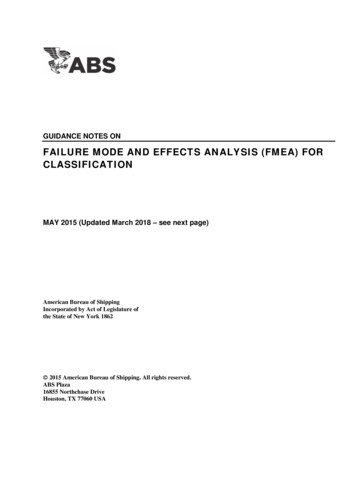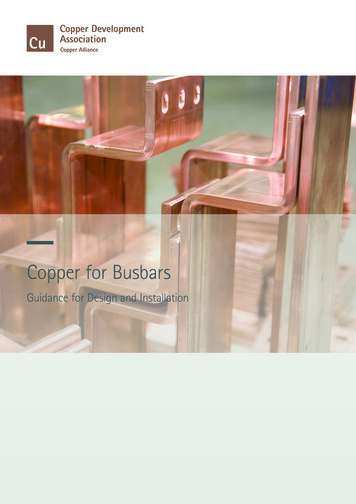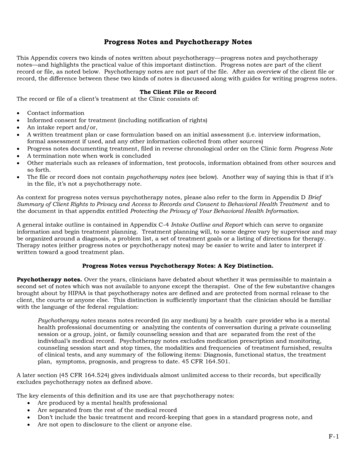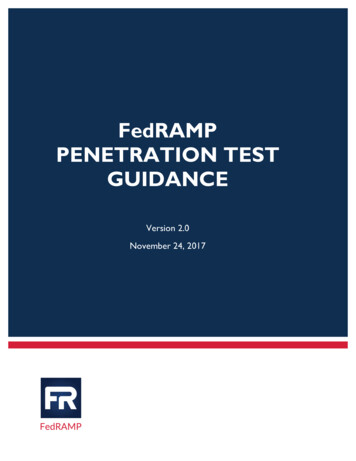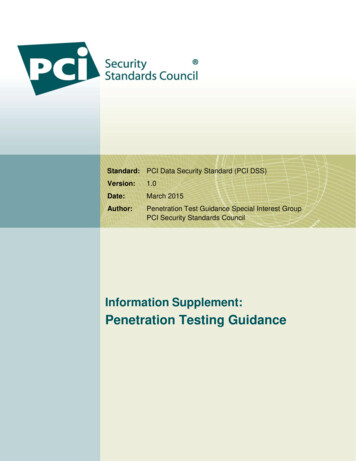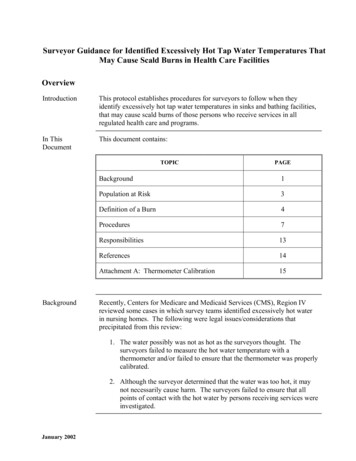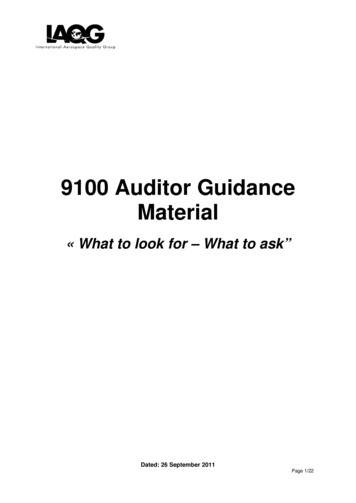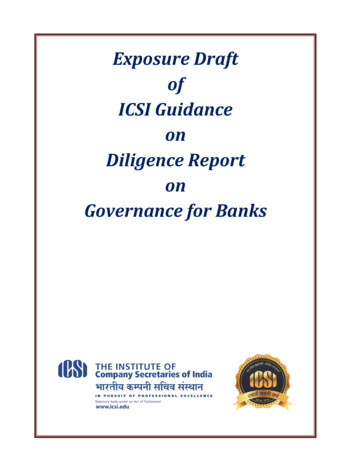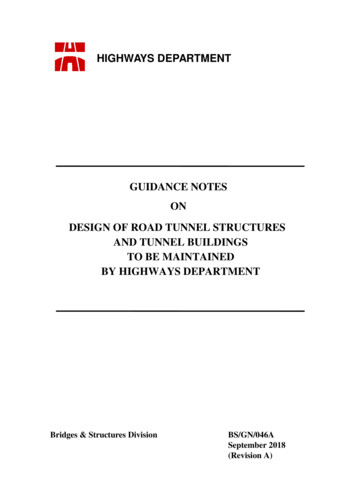
Transcription
HIGHWAYS DEPARTMENTGUIDANCE NOTESONDESIGN OF ROAD TUNNEL STRUCTURESAND TUNNEL BUILDINGSTO BE MAINTAINEDBY HIGHWAYS DEPARTMENTBridges & Structures DivisionBS/GN/046ASeptember 2018(Revision A)
CONTENT1.INTRODUCTION2.ROAD TUNNEL STRUCTURES2.1 GENERAL DESIGN REQUIREMENTS2.2 DESIGN WORKING LIFE2.3 TYPICAL COMPONENTS OF A ROAD TUNNEL2.4 TYPICAL LOADINGS TO BE CONSIDERED IN ROAD TUNNELSTRUCTURES2.4.1 EARTHQUAKE LOADS2.4.2 LOADINGS DUE TO EXTREME EVENTS2.4.3 COMBINATION OF LOADINGS2.4.4 EFFECT OF SHRINKAGE2.5 CONDITION OF EXPOSURES2.6 FIRE RESISTANCE2.6.1 FIRE RESISTANCE PERIOD2.6.2 VENTILATION PROVISION IN FIRE RESISTANCE DESIGN2.6.3 THERMAL BARRIER2.7 DRAINAGE DESIGN2.8 VENTILATION AND OTHER E&M SYSTEM2.9 MAINTENANCE CONSIDERATIONS2.9.1 MAINTENANCE CONSIDERATIONS IN PAVEMENTDESIGN AND HEADROOM REQUIREMENTS2.9.2 MAINTENANCE CONSIDERATIONS IN WATERPROOFINGDESIGN2.9.3 ACCESS FOR MAINTENANCE AND INSPECTION WORKS2.9.4 SPARE PARTS2.9.5 HANGING SYSTEM, HOLDING DOWN, ANCHORAGE ANDOTHER FIXING ARRANGEMENT2.9.6 INCORPORATION OF UTILITY INSTALLATIONS INTUNNELS2.9.7 TUNNEL MOVEMENTS MONITORING2.9.8 MAINTENANCE REQUIREMENTS FOR SPECIFICSTRUCTURAL FEATURES2.9.9 TUNNEL CLADDINGS3.TUNNEL BUILDINGS3.1 GENERAL STRUCTURAL DESIGN REQUIREMENTS3.2 DESIGN WORKING LIFE3.3 OTHER DESIGN REQUIREMENTS3.4 DESIGN REQUIREMENTS FOR TUNNEL BUILDINGS DESIGNEDFOR SPECIAL USE3.5 MAINTENANCE CONSIDERATIONS4.INDEPENDENT CHECKING4.1 ROAD TUNNEL STRUCTURES4.2 TUNNEL BUILDINGS5.ENQUIRIES6.REFERENCESPage 1 of 19
1.INTRODUCTIONThese Guidance Notes provide general guidance and requirements onstructural design considerations and maintenance provisions for road tunnelstructures and tunnel buildings to be maintained by HyD.A road tunnel is a subsurface structure for vehicular traffic constructedthrough or under an obstacle. This obstacle may be in the form of otherinfrastructure development, natural terrain, a mountain, a body of water orthe combination of the above. For the purpose of these Guidance Notes,road tunnel structures should include all major structures of a road tunnel,including permanent structural lining, structural compartments, portals, adits,ventilation buildings/shafts etc. which are structurally integrated with theroad tunnel structures.Road tunnels can be designed and constructed by different methods,depending on a number of factors, including functional requirements,geological and environmental considerations, construction methodologiesand technologies, plant and equipment etc.For demarcation purpose, an underpass is a highway structure that goesbeneath another road(s), railway(s) or other highway structures and is usuallyforming part of a local grade separated highway system. Reference should bemade to Structures Design Manual for Highways and Railways 2013 Edition(SDMHR) [1] for the design of the underpass.Tunnel buildings to be maintained by HyD are engineering structures such asventilation buildings, pumping station, kiosks, toll booths, satellite controlbuildings/points, control kioks etc. Tunnel buildings to be maintained byArchSD include administration buildings which is basically for officeaccommodation with human activities in support of tunnel operation,building elements such as internal finishes and architectural features,workshops and garages. A maintenance matrix should be devised and agreedat the design stage.The recommendations in these Guidance Notes will take immediate effect,and are applicable to projects which are new or under planning involvingroad tunnels or tunnel buildings to be maintained by HyD. In addition,designers and project offices should consult maintenance authorities tospecify Tunnel Protection Zone for road tunnels to prevent adverse impactdue to future developments.Page 2 of 19
These Guidance Notes should not be considered as exhaustive. Designersand project offices should also observe and comply with relevant up-to-datestandards and statutory requirements relating to safety, structural integrity,durability, maintenance and operational need, and ensure that provisions andrecommendations given in these Guidance Notes are applicable to theirdesigns.Designs of road tunnel structures and tunnel buildings to be maintained byHyD should be circulated to B&S Division for comments on structuraldesign aspects and respective Regional Offices on maintenance aspects.Designs on geotechnical aspects, geometry, traffic control and surveillance,E&M provisions, fire safety provisions, etc. are outside the scope of theseGuidance Notes. Designers and project office should seek advice fromrelevant authorities and departments accordingly.2.ROAD TUNNEL STRUCTURESRoad tunnels in Hong Kong are commonly constructed by the followingmethods/ combination of methods: (i) Boring by Tunnel Boring Machine(TBM), (ii) Drill-and-blast, (iii) Cut–and-cover and (iv) Prefabricated tubesimmersion. Designers and the project office should decide on the options tobe adopted in the design with due regard to functional need, constructability,safety, geological and environmental consideration, economy as well aslong-term durability and maintenance requirement, etc.2.1GENERAL DESIGN REQUIREMENTSThe structural design of road tunnels should take into consideration therequirements for tunnel operation, inspection and maintenance. The needsfor the provision of maintenance access, lighting, communication, utilitytroughs, electrical and mechanical installations, drainage, provision of fireservice installations, ventilation and traffic surveillance equipment etc.should be well addressed in advance of the structural design stage so as toassess their loading effects on road tunnels. Adequate maintenance accessand opening should be provided for the delivery of plant and materials formaintenance. Designers should seek comments and advice from relevantauthorities and parties.According to Code of Practice for Minimum Fire Service Installations andEquipment and Inspection, Testing and Maintenance of Installations andPage 3 of 19
Equipment [3] by Fire Services Department (FSD), systems for fire serviceinstallations and ventilation shall be provided when tunnel exceeds 230 m inlength.In practice, length of road tunnels in Hong Kong is usually longer than 230m.There are however exceptional cases that shorter road tunnels of length lessthan 230m exist in Hong Kong.2.2DESIGN WORKING LIFEUnless otherwise agreed, the design working life of road tunnels andassociated structures structurally integrated with tunnels should be taken as 120years. For the avoidance of doubt, any tunnel buildings which are structurallyintegrated with a tunnel or essential for tunnel operations, such as ventilationbuildings, ventilation shafts, etc., should be designed as tunnel structures with120 years of design working life.2.3TYPICAL COMPONENTS OF A ROAD TUNNELA road tunnel should be able to accommodate the designed envelope fortraffic movement as well as other functional and maintenance requirements,including ventilation, drainage, lighting, utilities and power, trafficsurveillance equipment, maintenance walkway and emergency cross passageetc. A typical road tunnel should contain the following structural elements:(i)(ii)(iii)Tunnel liningInternal wallSuspended ceiling slab for overhead ventilation ducts (OHVD) orother utility installation(iv) Suspension systems (e.g. hangers) for ceiling slab(v) Road slab and pavement(vi) Road plinth and safety walkway(vii) Cross passage(viii) Ventilation shaft / adits(ix) Portal structure(x) Approach ramp and retaining side wallsProvision of other non-structural components including road drainage, utilitytrough, non-structural cladding/ finishing, ventilation ducts, lighting, firefighting and traffic surveillance equipment etc. should also be considered inthe design.Page 4 of 19
2.4TYPICAL LOADINGS TO BE CONSIDERED IN ROAD TUNNELSTRUCTURESVarious loadings typical to road tunnel structures are listed below. The listof loadings shown below is not exhaustive. Designers should carefullyassess types, magnitudes and directions of loadings that would occur in roadtunnel and combine them in such a way with due consideration to producecritical structural i)(xii)(xiii)(xiv)Self-weight of all tunnel elements, supported carriageway, footpath,supported tunnel buildings, supported bridges and landscaped decks;Soil loads on tunnel structures;Groundwater, seepage forces and earth pressure loads as well asfloatation under various water tables;Loads arising from differential settlement of structures and structuralelements;Traffic loads;Accidental loads due to vehicle collision, vehicle explosion, fire load,impact of vessel anchors etc.;Dead loads and maintenance loads of E&M installations and vibrationloadings due to E&M equipment’s operations;Wind loads such as wind loads on tunnel portals and shafts;Loads due to temperature effects, creep and shrinkage;Earthquake loads;Loads during construction;All other existing loads on the top of the tunnel;Loads due to extreme weather, tidal impact and climate change effects;andLoads due to other planned development on top or in the vicinity ofroad tunnels, including future roads, buildings and infrastructuredevelopment2.4.1 EARTHQUAKE LOADSFor earthquake loads, road tunnels should be designed to withstand seismicforces and distortions imposed on them by lateral ground movementsresulted from the earthquake ground motion as well as dynamic loads arisenfrom the inertia response of structural elements under seismic actions. Thefollowing three types of deformations imposed by the surrounding ground,namely, (a) compression and extension in the longitudinal direction, (b)bending in the longitudinal direction, and (c) ovalling/ racking in thePage 5 of 19
transverse direction should be considered. Dynamic approaches as stated inEurocodes should be adopted in the structural analysis. For the purpose ofthe design of road tunnels, the Importance Factor as stated in SDMHR [1] forearthquake resistance should be 2.3 which corresponds to a return period of2500 years.2.4.2 LOADINGS DUE TO EXTREME EVENTSFor other effects arising from extreme weather, including the rise in sea level,abnormal rainfall intensities, temperature changes etc., precautionarymeasures such as raised road profile at entrances, tunnel sumps, entrancebarriers and floodgates etc. should be considered in the design. Commentsfrom relevant authorities including HKO, DSD and CEDD should be soughtwhere appropriate.2.4.3 COMBINATION OF LOADINGSAs regards the various combination of loadings acting on road tunnelsarising from surrounding interfaces, including soil, rock, aqueous bodies andother imposed loads due to other structures and geotechnical features etc.,designers should consult and agree with the relevant authorities ongeotechnical aspects with regard to the geotechnical design parameters,assumptions and designed loads to be adopted for assessing and designingroad tunnels.2.4.4 EFFECT OF SHRINKAGEEffect of shrinkage due to different humidity across the depth of thepavement/lining should be duly considered in particular when the back ofpavement/lining is close to the source of subsurface run-off or seepage.2.5CONDITION OF EXPOSURESThe design condition of exposures, nominal cover to reinforcement anddesign crack width to be adopted for reinforced concrete elements wouldhave significant influence on the durability of road tunnels. Exposure classXC4 in Table 5.2 of SDMHR [1] with limiting crack width of 0.25mm shallbe adopted for assuming the durability of road tunnel elements under theaggressive environment of road tunnel.Notwithstanding the above, designers should carry out reviews andPage 6 of 19
assessments in order to specify exposure class which commensurate with thetunnel’s specific situations and other controlling factors such as humidity,carbon dioxide concentration, design assumptions and concrete protectivemeasures, etc. Designers should provide full substantiations if lowerexposure class is adopted to ensure the adequacy of concrete cover inprotection against carbonation.2.6FIRE RESISTANCE(1) Road tunnels should be designed to prevent catastrophic collapse andspalling of concrete in the case of a fire incident so as not to endanger tunnelusers during evacuation and firefighters in fire-fighting or rescue. Designersshould adopt the latest fire design codes and comply with the latestrequirements of FSD in the design of tunnel structures.(2) Designers should assess fire risks of road tunnels and their consequences andadopt risk mitigation measures for various elements of road tunnelsaccording to relevant fire design codes. The fire curves to be used, elementsto be protected, forms and extents of protection required should be assessedwith due considerations of fire exposure by the designers. Time forrepairing and re-opening the tunnel to traffic due to various fire conditionsand the associated long-term performance, inspection and maintenancerequirements after respective fire conditions should also be addressed in thedesign.(3) To reduce the risk of concrete spalling under fire for all structural concrete,monofilament propylene fibres not less than 1.5kg/m3 shall be included inthe concrete mix regardless of any thermal barrier to be installed. The fibresshall be 6 – 12mm long and 18 – 32 μm in diameter, and shall have a meltingpoint less than 180 . Wire mesh should not be adopted in the prevention ofconcrete spalling under fire.2.6.1 FIRE RESISTANCE PERIODAs a general rule, the Fire Resistance Period should be taken as 4 hoursunless agreed otherwise. Designers should document all considerations forderiving the adopted Fire Resistance Period in the design of road tunnelstructures. Designers should also check with relevant authorities includingFSD and TD with regard to any specific fire resistance requirements,prohibition of dangerous goods vehicles from using road tunnels, etc. indetermining the Fire Resistance Period
2.8 ventilation and other e&m system . 2.9 maintenance considerations . 2.9.1 maintenance considerations in pavement design and headroom requirements . 2.9.2 File Size: 241KBPage Count: 20

